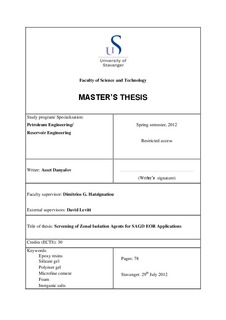| dc.contributor.author | Danyalov, Asset | |
| dc.date.accessioned | 2014-02-06T09:27:04Z | |
| dc.date.issued | 2012 | |
| dc.identifier.citation | Conf. until june 2014 | no_NO |
| dc.identifier.uri | http://hdl.handle.net/11250/183628 | |
| dc.description | Master's thesis in Petroleum engineering | no_NO |
| dc.description.abstract | Utilization of Steam Assisted Gravity Drainage (SAGD) features is currently one of the most widely applied technologies for production of bitumen oil in Canadian oil sand fields. However, as in most oil and gas reservoirs, the bitumen oil reservoirs also differ depending on their reservoir structure; for the Surmont field case in Athabasca oil sands region, the lack of natural sealing and presence of overlying thief zones became a point of concern for a conventional application of the SAGD method.
The conventional operational conditions of the SAGD process were considered to be less efficient or not applicable in the presence of the overlying thief zones and lack of natural barrier because of the potential energy losses from the steam chamber. There is also a high risk of the SAGD well pair shut-down due to influx of undesired fluids owing to pressure communication between the bitumen reservoir and the overlying gas and water zones.
This work is done as a part of an ongoing research seeking to resolve the thief zone issue, and aims to (a) develop the main requirements for chemical isolation method for the Surmont field and (b) evaluate the wide range of possible isolation products in order to find the appropriate systems satisfying the established requirements.
As a result of a literature review and communications with relevant technical experts, a preliminary screening was conducted by ranking the products based on their potential and possible technical restrictions for thief zone treatment. At this stage, products considered to having serious limitations for such treatment were eliminated from further evaluation. For example, cement was considered to having serious injectivity issues as result of particles size; simple inorganic salts not having enough plugging ability; and foam systems due to lack of yield strength. The few promising products (polymers, silicate, and epoxy resins) were chosen for a further experimental screening.
Based on the criteria identified for an effective treatment of thief zones, relevant experimental tests assisted to narrow down the possible isolation products by eliminating the aqueous gel systems (silicates and polymers) due to their instability at high temperatures. The experimental results indicated that the epoxy system is the most effective plugging agent. The laboratory findings also showed that the initially perceived epoxy system injectivity limitations can be resolved by a proper formulation of the epoxy components and relevant solvents. | no_NO |
| dc.language.iso | eng | no_NO |
| dc.publisher | University of Stavanger, Norway | no_NO |
| dc.relation.ispartofseries | Masteroppgave/UIS-TN-IPT/2012; | |
| dc.subject | petroleumsteknologi | no_NO |
| dc.subject | reservoarteknologi | no_NO |
| dc.subject | epoxy resins | no_NO |
| dc.subject | silicate gels | no_NO |
| dc.subject | polymer gel | no_NO |
| dc.subject | microfine cement | no_NO |
| dc.subject | foam | no_NO |
| dc.subject | inorganic salts | no_NO |
| dc.title | Screening of zonal isolation agents for SAGD EOR applications | no_NO |
| dc.type | Master thesis | no_NO |
| dc.subject.nsi | VDP::Technology: 500::Rock and petroleum disciplines: 510::Petroleum engineering: 512 | no_NO |
| dc.description.embargo | 2014-06-15 | |
